Two-Stroke Extravaganza
There was a ringing in my ear, and for a change it wasn’t the neighbor’s leafblower at 7 a.m. on a Sunday morning. It was more of an echo-chamberish “ringy-dingy,” a description often used in jest or derision when speaking of those non-four-stroke motorcycles of semi-yore.
But where there’s smoke there’s often fire-breathing bikes, and that was the case recently at the 10th Annual Two-Stroke Extravaganza held at Woodley Park in the Los Angeles area. There was, you could say, a symphony (some would say cacophony) of bikes with letters for names: RD, RG, RZV, TZ. There were Singles, Twins, Triples, Fours – the full smorgasbord of hi-revving two-strokers included several “non-filtered” racers, home-grown hybrids and totally stock 1960-1990 show bikes, many meticulously restored.
Why was I there? Sentiment? Nostalgia? Sheer fear? Some moons before Neil Armstrong reached the lunar surface, I had performed my very first wheelie as a novice rider aboard my 2-stroke Yamaha RD350. At a near 90-degree angle, I split lanes between a dozen cars. When I pulled over, my friends rushed up to me to congratulate me on the feat. I nodded nonchalantly without mentioning I had not planned on the event and in fact thought I was going to end up as SUV splat. But true courage is going with the flow even when overcome by panic, right? So I took the kudos but passed on the Kawi H-2 750cc Triple I later tried on for size. I heard this little voice in my head: “This bike will kill you.” (I listen to voices in my head, so what?)
So here I was at Woodley Park, a non-smoker with about 1000 exhaust-fume fanatics. It was a nice sunny, non-smoggy day when normal people were barbecuing tofu or reading a good book on Nervous Leg Syndrome, and here I was semi-reliving my two-stroke youth. Then I saw something, a bit of eye poetry that summed it all up. It was in the form of the event T-shirt: “The Swarm.” The illustration showed a squadron of wasp-like creatures with two-stroke expansion chambers buzzing away.
Then I saw the baby-blue Suzuki T500. Was that my T500 from pre-divorce, plenty-of-bikes-in-the-garage days? It was a homecoming of sorts since the T500 was my second two-stroke bike. It still cut the mustard with its sharp clean, compact lines. And then in triple déjà-vu, I came upon a 350cc Allstate/Austrian Puch, the third bike in my two-stroke pantheon. (No puking jokes please, unless I make them.)
There was no charge to ogle your past, present or possible 2-stroke future, but I did lay out some green for the chance to win some cool bike gear including a high-impact graphic Arai helmet and a yiffy spiffy Yamaha racing jacket. There were a slew of other raffle prizes as well, including literally gallons of Motul oil, 2-stroke of course. And it was all for a good cause: funds for the medical expenses incurred by Doug Johnson, the original founder of the event several years ago, a highly respected and well-liked motorcyclist who while already previously injured and in a wheel-chair suffered even more severe injuries in an accident that left him in a coma. However there was some Good Karma in the air. The fellow who won the helmet had flown in from London just for the one-day event. Good show, Ashley! (Do you get motorcycle.com in England?)
When the dust and two-stroke smoke cleared at the end of the day, the show winners included: Best RZ350 (Allan Owens); Best Modified ’80s TZ250 (Mark Otliang); Best Stock ’90s (Russ Truex’s TZR250; Best Daytona (Robert Rogers); Best 500 (Nick Gargano’s Walter Wolf); Best Stock Triple (Dan Armbrecht’s ’75 Kawi H-2 750 Triple); Best ’70s Modified (Bill Dussell’s ’74 RD350); Best Rat Bike (Stan BeeBe); Best ’80s Race Bike (Warren Spradlin, Jr.); Best European Bike (Mr. Gacelli’s 1959 Cecatto). In addition, Victor Rothgarn won three awards including Best Modified Triple and Best Enduro.
Two other two-strokes required serious crowd control – one had four wheels, the other none at all. Case in point, a 250cc 2-stroke powered pogo stick. Called “The Hop Rod,” it was sold in the late 1960s (for $74.50) before lawsuits were in fashion and liability was in the hands of anyone intrepid enough to try riding it. The story goes that the son of the inventor while demonstrating it on a TV talk show launched himself in the host’s desk and broke several bones on live television. So far this example has yet to be flown.
Perhaps even more bizarre was the winner of the “Best Exotic.” It happened to be a mini sports car, a 1959 Berkeley 492 owned by L.A. stand-up comedian George Gray and his wife Nicole. What lay under the hood qualified it and also caused a bit of a controversy. A first glance at the two-stroke Triple and you’d say, hey, someone stuffed a Kawi Triple into a kit car. A closer inspection of the limited-production British-built racers reveals the name “Excelsior” emblazoned on the primary cover. It also features a pre-unit four-speed tranny built for motorcycles, an aluminum frame and fiberglass bodywork weighing about 700 lbs. It’s said to be good for 100 mph.
“This car was in storage for about 35 years,” says its owner George Gray. “I got it about five years ago since my Pop used to race one these things. As for the engine, the story goes that Kawasaki used this engine design to build their Triples.” Says Nicole Gray, “It’s hard not to have a big fat smile when you’re riding in this thing… especially when you hear the weeemmmmmyyyy!!! coming out of the engine.”
Another show entry that got people’s attention was Nick Gargano’s very predatory “shark-toothed fighter plane” themed 1985 RZR350. In fact when the ballots were cast it went home with the People’s Choice Award.
Another star of the event was a 1975 Kawasaki H-2 Triple that blew no smoke at all. In fact its owner had bought in back in ’75 when it was announced that it would be the last year for the notorious bike. The plan was to keep it crated for a couple years then starting riding it. But 25 years later it was still in the crate. It’s out of the crate now but never given gas or started. Zero miles! Now that’s a serious bit of 2-stroke history. And the Woodley Park 2-Stroke Extravaganza was the fitting place for its appearance.
Be there for the 11th annual event next September. And if you have a Hop Pod, just pogo on over. As always, all two-strokes welcome.
While steam engines powered many of the earliest attempts of motorized cycles in the mid-late 1880s, the Frenchies get to lay claim for first outlining the principle of the four-stroke engine, specifically in 1862 by a monsieur named Alphonse Beau de Rochas. Germans won kudos in 1876 for patenting the first working four-stroke application.
It was not until 1880 that a certain Dugald Clerk (later Sir Dugald Clark thanks to his contributions to the English war effort), designed a workable two-stroke design. A patent was issued in 1904 for the first two-stroke engine, in this case a V-Twin, to Alfred Scott – an engineer certainly not to be scoffed at, as he also later came up the rotary valve engine design in 1912.
The two-stroke design philosophy centers around efficiency and an economy of components, obviously fewer than the number required by four-stroke engines that utilize camshafts and valves. Fewer parts also meant they are lighter - pound for pound, they produce more power than a four-stroke. However, four-strokes are noticeably less polluting, for the most part more durable and reliable and offer a wide powerband.
Two-strokes burst upon the motorcycle scene in a big way during the 1960s World Championships when Yamaha and Suzuki took command. What won on the track won on the showroom floor as well, resulting in a plethora of ring-dingers literally popping up. Soon done away with was the messy separate mixing of oil and gasoline when Yamaha introduced its “Autolube” design that automatically mixed both fuel and lubricant.
The earth shook in the face of fearsome two-stroke predators during 1970s, including a full smorgasbord from Kawasaki in the form of 250, 350, 500, and 750cc Triples, while Suzuki offered a menu of 380, 550 and 750cc.
In the mid-1980s, manufacturers began to offer liquid-cooled GP replicas such as the V-4 Yamaha RZ500, the square-Four Suzuki RG500 and the V-3 Honda NSR400. Unfortunately, Canada was the closest these screamers ever came to America aside from a few creatively imported examples.
Politically correctness and a lot of coughing finally sought to blacklist two-strokes from government acceptability. In an end run, Yamaha introduced a catalyst-equipped RZ350 to America in 1984, but its demise in 1985 signaled an end of an era. Meanwhile, Europe and Japan enjoyed lithe quarter-liter GP replicas for while, only being killed off for good in recent years. Today, two-strokes only exist in the scooter and dirtbike realms, and even there they are a dying breed.
Two-strokers live on in off-road bikes and leafblowers, both still fast, furious and raucously ringy dingy – music to the ears of many motorcycle enthusiasts.
Related Reading:
RZ500 – The Grand Prix Fantasy
More by Paul Garson



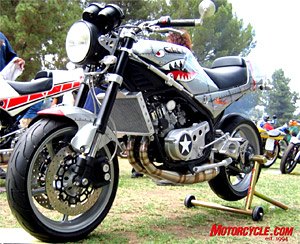













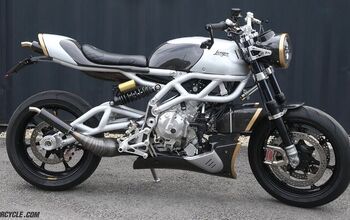
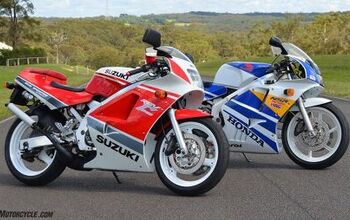
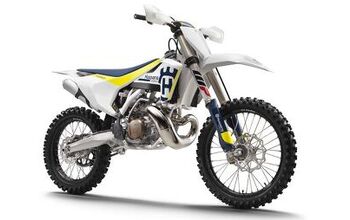

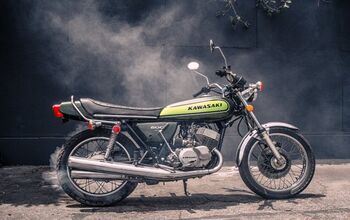













Comments
Join the conversation